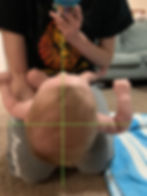Help! What is a Flat Spot and Does my Child Need a Helmet?
- Dr. Emily Stefan, PT, DPT
- May 31, 2023
- 2 min read

Been working overtime trying to get your baby away from that flat spot with what doesn’t seem like a lot of improvement? Thinking about whether a helmet would be beneficial or not to improve your child’s plagiocephaly? Here is a step by step guide to monitoring your baby’s flat spot!
Different Head Shapes
First, it may be beneficial to talk about the different types of headshapes. There are 3 types of asymmetrical head shapes that may be from birth or from a baby's preference to stay in a certain position. Here they are (image from Clutterbugs Pediatric Therapy):

Plagiocephaly: This is when one side of the back of the head becomes flat. It can be associated with torticollis or with preference to look one way and not the other.
Brachycephaly: This is when the back center of the head becomes flat and can be associated with lots of time spent on the back and maybe not a lot of time in tummy time.
Scaphocephaly: This is when the head is long and skinny, and some people describe it as "cone head".
How to Monitor Head Shape Over Time


1. Take 2 pictures, one from a bird’s eye view with nose pointing straight up to the sky and one face-on. Make sure each picture is level.
2. In the bird’s eye view, draw one line vertically through the center of the nose then horizontally through the middle of the head. In the face-on picture, one line goes vertical through the center of the nose and the other horizontally through the eyes.
3. Take these pictures every 2 weeks and compare each time to monitor the shape of your little one’s head to help you see progress or lack thereof.
Here is what I notice as asymmetries for this head in particular to help you decipher head shape of your own little one:

Who decides if your baby needs a helmet?
YOU! Even though doctors and therapists make recommendations on what they think will be most helpful, the ultimate decision is up to you as a caregiver. Everyone has the right to their own opinion, and this one is yours. Not your doctor’s, not your therapist’s, not anyone at cranial technologies! So you make this choice for you and your family and let’s try to make the world more of a judgement free zone!
When do we need to make the decision by?
The research shows that there is no difference in the rate (how fast head shape improves) and duration (how long they need the helmet for) of improvement with helmet therapy starting at 3, 4, or 5 months old. However, starting after 6 months of age results in improvements that were significantly lower and duration of therapy was significantly increased. So, the magic number here is 5 months!
My Recommendations Before Helmet Therapy
Here are my recommendations that your child should demonstrate before starting helmet therapy:
- Good head control
- Tolerates tummy time for at least 1 hour cumulative per day
References:
Mi-hyang Han et al. (2017). “Relationship between starting age of cranial-remolding-orthosis therapy and effectiveness of treatment in children with deformational plagiocephaly”



